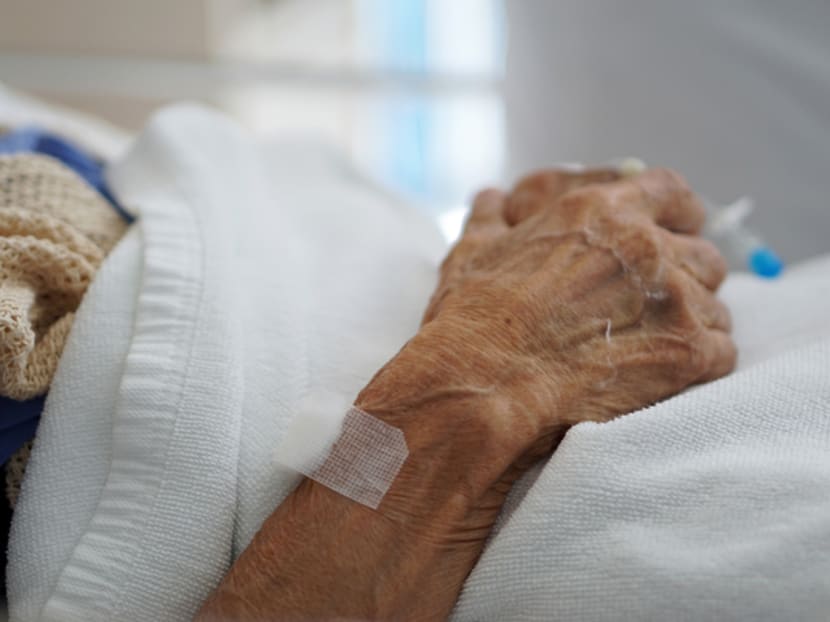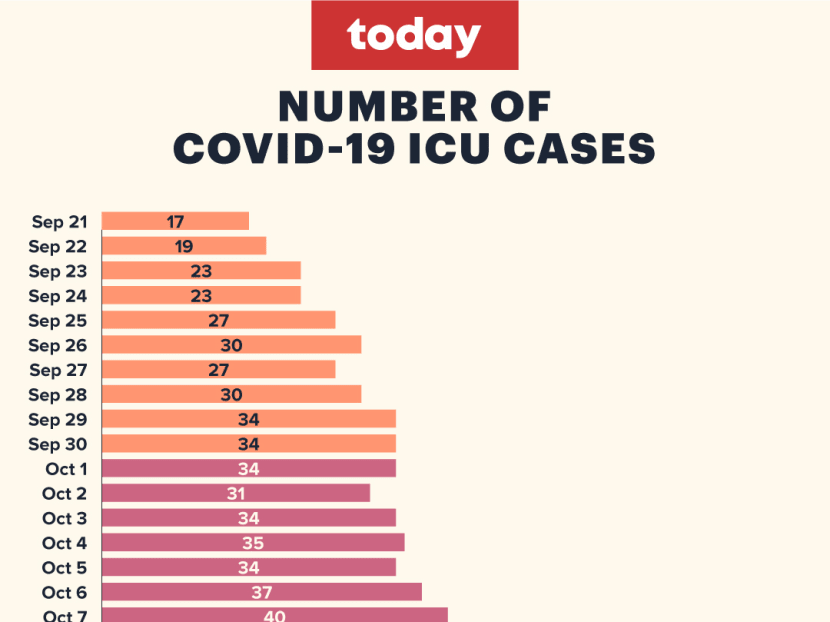Explainer: Has the Covid-19 stabilisation phase been effective, and what can we expect next?
SINGAPORE — While daily Covid-19 case numbers appear to have stabilised over the past week, infectious disease experts told TODAY that a continued increase in total intensive care unit (ICU) cases remains the main concern. They are largely uncertain over whether the Government’s one-month stabilisation phase had been successful in that regard.

Some infectious disease experts believe it may be too soon to judge whether Covid-19 cases requiring intensive care unit (ICU) care have peaked.
- The stabilisation phase from Sept 27 to Oct 24 was implemented to minimise the strain on overall healthcare capacity
- While the number of new infections appears to have stabilised, experts noted that the number of Covid-19 patients in ICU has continued to rise
- The experts are split as to whether the increasing number of those severely ill is a cause for concern
- Moving forward, they hope that there will be fewer community-wide restrictions, and more focus on vulnerable groups like the elderly
SINGAPORE — While daily Covid-19 case numbers appear to have stabilised over the past week, infectious disease experts told TODAY that a continued increase in total intensive care unit (ICU) cases remains the main concern. They are largely uncertain over whether the Government’s one-month stabilisation phase had been successful in that regard.
In a Facebook post on Oct 12, Health Minister Ong Ye Kung said that the stabilisation phase had appeared to moderate the transmission wave, as “infection numbers are no longer doubling every week”.
This stabilisation phase, from Sept 27 to Sunday (Oct 24), was implemented to minimise the strain on the overall healthcare capacity. Social gatherings were capped to a maximum of two, and work from home became the default arrangement, among other measures.
TODAY speaks to experts on the efficacy of the measures in easing the strain on healthcare institutions here, and what we can expect after Oct 24.
TOTAL CASE NUMBERS, THOUGH STABLE, SHOULD NOT BE THE FOCUS
Experts said that the numbers of ICU cases, hospitalisations, and those requiring oxygen supplementation remain the key indicators of success, as they offer an insight into how strained the healthcare system is.
While community cases had surged in September, daily community infections have largely hovered in the 2,000s range of late. In the two weeks since Oct 5, the peak number of new community cases was 2,933 cases on Oct 6, and the lowest was 1,949 cases on Oct 11.
Dr Alex Cook from the National University of Singapore’s (NUS’) Saw Swee Hock School of Public Health said that with the new Covid-19 protocols announced earlier this month, there may be a higher incidence of “cryptic” cases, or cases not included in the official tally.
For instance, those who have asymptomatic Covid-19 can depend on their antigen rapid tests (ARTs) and recover at home by themselves, and do not need to visit the doctor to be officially tested.
Thus, the stabilisation in the number of reported cases may not mean that there are fewer community infections.
“The recent changes mean that we can no longer compare the absolute number of cases to those from several weeks ago,” he said.
Whether accurate or not, the raw case numbers are not meaningful in Singapore’s context, as most are not serious or asymptomatic, said Dr Asok Kurup from Mount Elizabeth Hospital.
The Ministry of Health said in its daily Covid-19 update on Monday that over the last 28 days, 98.6 per cent of local infected cases were asymptomatic or had mild symptoms.
“What actually truly matters is the number of people who need high-resource care in healthcare situations, which includes people who are on oxygen support and people who are critically ill,” Dr Asok said.
EXPERTS SPLIT ON THE SUCCESS OF STABILISATION MEASURES
The total number of cases warded in ICU has steadily increased from 17 cases on Sept 21, to 27 cases on Sept 27 when the stabilisation measures were implemented, to 67 cases on Monday. This went up to 71 on Tuesday, as Singapore logged a record 3,994 new Covid-19 infections.

The total number of cases requiring oxygen supplementation has also increased steadily from 147 on Sept 21, to 194 on Sept 27, to 338 on Tuesday.
The experts are split as to whether the increasing number of those severely ill patients is a cause for concern.
Professor Tikki Elka Pangestu, a visiting professor at NUS’ Yong Loo Lin School of Medicine, said that it is no surprise that the ICU numbers are increasing, as they correspond to the increase in the number of new cases.
“The increase seen is also due to a lag effect (where) we are seeing ICU cases who were infected maybe one to two weeks ago when the numbers were higher,” he said.
He said that the stabilisation phase has “worked as a whole” as the number of new infections appears to be plateauing. He expects the number of ICU cases to follow suit as the virus “runs out of susceptible hosts”.
Agreeing, Associate Professor Hsu Li Yang, the vice-dean (global health) at NUS’ Saw Swee Hock School of Public Health, said that the stabilisation measures appear to have slowed down the spread of the virus, compared to “mathematical models of a scenario without physical distancing”.
However, he added that it is still too early to ascertain if the measures have worked to bring down ICU cases, as the lag means that the present increase in ICU cases is just “a fraction of events that took place up to two weeks ago”.
“Hence there is less clarity on the present state of the pandemic.”
Dr Cook added that it would be clearer if the daily Covid-19 updates could include the number of new cases admitted into the ICU and who need oxygen supplementation daily, rather than showing the cumulative total.
For instance, the total number of warded ICU cases does not include the patients who may have passed away, or who have recovered, as they will be removed from the tally.
“This is relevant for healthcare utilisation, but obscures day to day changes… It’s hard to measure how much the stabilisation measures have influenced the epidemic trajectory as a result,” he said.
Dr Asok said on the other hand that it is unlikely that the number of ICU cases has reached its peak, and he believes there may be a further extension of the prevailing measures due to this.
“We haven’t seen the peak yet, once you hit the peak and there is downward trend in ICU numbers, then (the authorities) can manage around it.”
LOOSEN, TIGHTEN, OR STAY THE COURSE?
The experts largely agree that given the endemicity of the virus, the tightening or loosening of restrictions will not have a big impact on case numbers.
Professor Paul Tambyah, president of the Asia Pacific Society of Clinical Microbiology and Infection, said he does not think loosening the restrictions to the previous set of measures, where the maximum group size was five, would lead to a surge in infections.
“The disease is all over Singapore right now and the priority should be reaching out to the unvaccinated seniors and protecting the vulnerable rather than taking measures which adversely affect the bulk of the population with little benefit,” he said.
Dr Asok added that the authorities could consider doing away with trying to detect asymptomatic or mild cases, as doing so through routine testing, for instance, is too resource intensive.
“We are living with the virus, so if you are asymptomatic, what can you do, with the community already so heavily contaminated as it is?
“Getting all worked up about these statistics is not consistent with measures to try to live with the virus.”
Dr Cook said that in living with the virus, Singapore has to expect that the current wave of community infections is not the last.
“Once we relax more measures the immunity from wave one will not be enough to prevent a second wave under relaxed measures,” he said. “We may need to go through two to three waves before eventually we are completely back to normalcy.”
In the meantime, he said that a large proportion of severe outcomes and deaths from the virus still come from a “small fraction of the population who are unvaccinated”.
Moving forward, he said there is a “strong argument” for revoking the privilege of free medical care for Covid-19 for those who have declined the vaccine, excluding those who are medically unable to be vaccinated.
“This group of people is putting immense strain on the healthcare system, and preventing other people who need a hospital bed from getting one, for no good reason,” he said.








